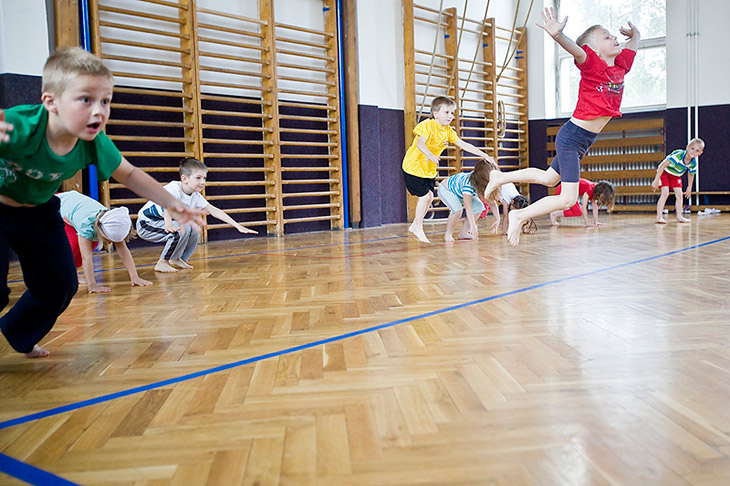Dance And Kinetic Education Within Primary Curriculum
Within the scope of the Strategy of the Ministry of Education for 2020-2030, background studies are being prepared, aimed at reviewing of the Framework Educational Programmes in all areas of education.
As far as the area of Arts and Culture is concerned, members of the review expert group met with members of the Art and Culture expert team to jointly address issues related to this area consisting of five artistic disciplines: Music, Art, Dance and Movement, Drama and Film/Audiovisual Education.
Duncan Institute was invited by the National Institute for Education to participate in preparation of the report on the subject Dance and Movement Education. The background study for the revision has been completed following extensive discussions and is available for download here (PDF).

Photo Vojtěch Brtnický
Dance and Kinetic Education as a supplementary school subject
Dance and Kinetic Education (TPV) was included in the Basic Education Programme for Primary Curriculum on July 30, 2010, at the behest of the Minister of Education, effective as of September 1, 2010. The subject was incorporated in the educational sphere 5.10 (arts and culture) as a supplemetary school subject. The TPV can be utilised as a supplemenetary subject for all pupils of primary schools, and it can be a compulsory or an elective course. As a supplementary subject, the TPV can enrich the course selection. The inclusion of the TPV as a school subject is the result of the hard work of the expert team led by Eva Blažíčková who in cooperation with the Pedagogic Research Institute in Prague prepared the concept of the subject. Eva Blažíčková, founder of the Duncan Centre Conservatory, is the author of the approved description and content of the TPV; she was officially requested to submit the concept by the Dance Vision (Vize tance) association.
Methodic support for Dance and Kinetic Education in primary schools
In 2009 the expert team of the Society for Dance and Artistic Education, composed of Eva Blažíčková and PhDr. Romana Lisnerová began to prepare a project that would provide the hitherto lacking expert methodic support to the schools introducing the Dance and Kinetic Education (TPV) courses in their curriculum. Other partner organisations of the Duncan Centre Conservatory and the National Institute for Further Education (NIDV) were invited to partake in the project. Three pilot primary schools in Prague (Chmelnice, Školní, Slivenec) started to teach the TPV. The project also resulted in the 2011 publication of a practical methodic manual titled The Dance and Kinetic Education in First Grades of Primary Schools, which includes examples of good implementation of the course and an instructional DVD. A support network of primary schools who can guarantee methodic support to their regional partners was also created.
Dance and Kinetic Education – its description and content
Eva Blažíčková
The TPV uses the specifics of dance to form a child’s personality. It builds permanent relations between the child’s thinking, emotions and body. It harmonises the child’s physical development. It nourishes the child’s creativity, sensitivity, perceptual abilities, and bodily intelligence. It teaches the child to be responsive to their environment, it develops their social intelligence. It teaches spontaneity and self-discipline simultaneously. It boosts a positive relation to physical activities.
In order to achieve these goals it is necessary to pay attention to the four spheres that permeate all actions and in various forms are present in the entire scope of the education. These spheres are: Searching for a Place, Development of Bodily Intelligence, Originality, and Creation of a Community.

Photo Vojtěch Brtnický
Spheres of creative activity
The sphere of Searching for a Place contains activities through which students search and examine the space of their bodies, activities that convey and visualise the idea of the body’s physical connection to the surrounding space. The sensation of awareness of one’s body in the spatial context leads to the realisation of one’s own uniqueness within belonging to the whole – tuning in with the order of the world. This realisation is accompanied by respect, humility, and freedom.
The sphere of Development of Bodily Intelligence contains activities aiming at developing the natural (i.e. the correct) utilisation of movement, depending on individual anatomic, physiological and psychological preconditions. This long-term process, subject to will, leads to qualities obtained and developed in accordance with the intention, talent and intelligence. The activities focused on developing bodily intelligence are not a matter of mechanical repetition or drill.
The sphere of Originality contains activities developing students‘ personalities and throughout a long-term process help them find their unique ways of expressing the world. The aim of true genuine originality is not to shock and attract attention at any cost.
It is a path of a unique rendition of an already existing morphology. The goal is to assist personalities capable of achieving such authenticity in their process of growth.
The sphere of Creation of a Community contains activities evoking the sensation of belonging and sharing. The sense of community is a fundamental human need that can be conveyed by dance. Dance has always been an inherent part of the tribe, the community, the society – its extraordinary power can rediscover and revive the joy of emotions resulting from belonging and sharing. This can transform the modes of communication and counter feelings of alienation and uprooting.
Every activity contains a certain share of elements of all four spheres.
